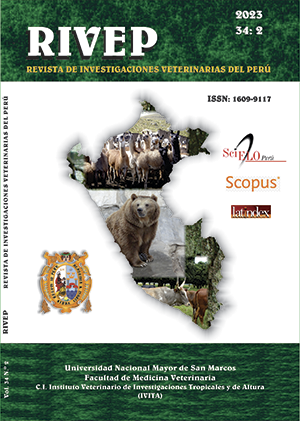Productive response of rainbow trout (Oncorhynchus mykiss) to the feeding regime with commercial feeds under intensive farming conditions in Lake Titicaca
DOI:
https://doi.org/10.15381/rivep.v34i2.25131Keywords:
feeding regimen, commercial feeds, trouts, productive performanceAbstract
The aim of this study was to determine the effect of two feeding regimes (7 vs 6 d) and three commercial foods (TO= Tomasino®, NA= Naltech® and SA= Salmofood®) on the productive-commercial performance and organ development. of rainbow trout in the fattening phase under conditions of Lake Titicaca, Peru. A total of 1080 trout of 185 g live weight (LW), 26.5 cm total length (TL) and 1.00 body condition index (BCI) were randomly placed in 36 1.2x1.2x1.6 m nylon cages (30 trout/cage). The control of productive parameters (LW, TL and feed consumption) was carried out at 30, 60 and 90 d. The BCI, the mean daily feed intake (DFI), the mean daily weight gain (DWG) and the feed conversion ratio (FCR) were determined. The carcass yield (CY), fillet yield (FY), pigmentation (MP) and the relative weight of the organs were determined at 215 d. The feeding regime did not affect the LW, TL and BCI, but the 7-d feeding had a better FCR (1.12 vs 1.25; p<0.001). Feeding with TO and NA produced lower DFI (3.7, 4.0 and 4.3 g/d; p<0.001), lower DWG (2.9, 3.3 and 4.1 g/d; p<0.001) and worse FCR (1.27, 1.21 and 1.07; p<0.001) with respect to SA at 90 d, respectively. The CY, FY and MP were not affected, but the relative weights of the liver and heart were influenced by feed. It is concluded that the 7-d diet improved feed conversion and pigmentation, while commercial feeds influenced productive performance, pigmentation and relative weight of organs, but not carcass and fillet yield of trout.
Downloads
Downloads
Published
Issue
Section
License
Copyright (c) 2023 Marina Flores Mendoza, Rosario Ortega B., María del Pilar Blanco E., Marcelino J. Araníbar

This work is licensed under a Creative Commons Attribution 4.0 International License.
AUTHORS RETAIN THEIR RIGHTS:
a. Authors retain their trade mark rights and patent, and also on any process or procedure described in the article.
b. Authors retain their right to share, copy, distribute, perform and publicly communicate their article (eg, to place their article in an institutional repository or publish it in a book), with an acknowledgment of its initial publication in the Revista de Investigaciones Veterinarias del Perú (RIVEP).
c. Authors retain theirs right to make a subsequent publication of their work, to use the article or any part thereof (eg a compilation of his papers, lecture notes, thesis, or a book), always indicating the source of publication (the originator of the work, journal, volume, number and date).










